What exactly is a petrified forest? Well, it is a collection of fossilized trees that have been converted into stone. This extremely slow process is called mineralization. Petrified forests can date back to the Triassic period, nearly 200 million years ago. They are usually found where rivers have deposited sediments that preserve the wood from decay.
Arizona has one of the biggest petrified forests in the world. Located about 25 miles east of Holbrook, Petrified Forest National Park covers 346 square miles. This area was declared a national monument in 1906 and a national park in 1962.
Arizona’s Petrified Forest holds many interesting facts about itself, and here are 10 of some of the most amazing ones.
1. It Is a Paleontologist’s Dream
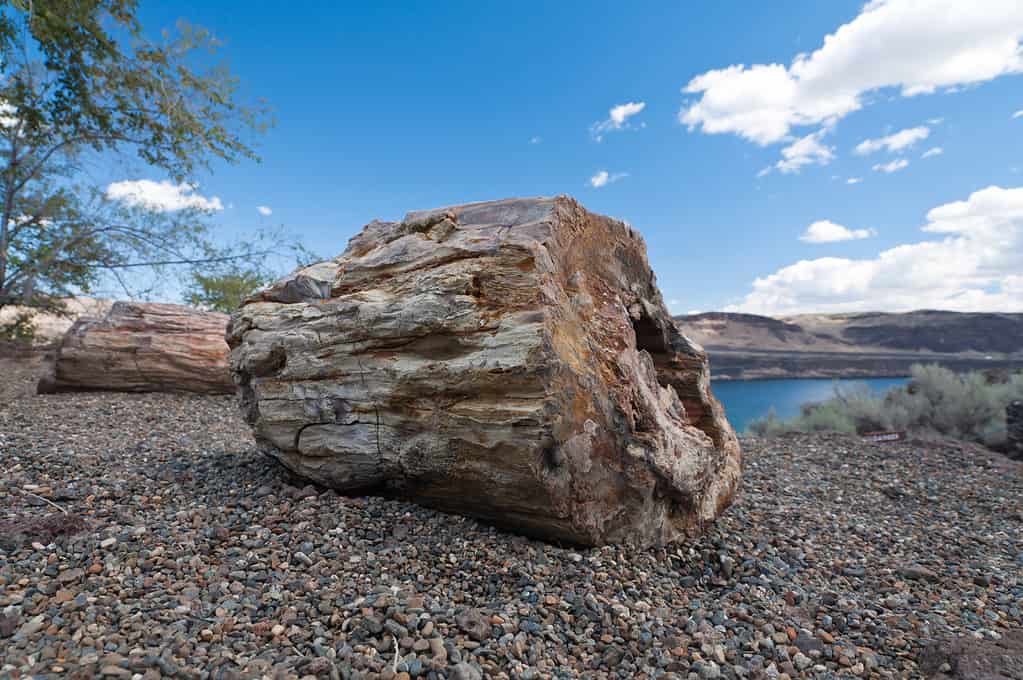
There are more than 50 species of petrified wood found inside the park.
©iStock.com/unclegene
Dinosaurs once lived here in this national park. The Petrified Forest has plant and animal fossils that date back to the Triassic Period, almost 200 million years ago. Before the Arizona that everyone knows now, this area was once a quiet, tropical, swampy rainforest. Reptiles, dinosaurs, and prehistoric vegetation all encompassed this area.
Because of tectonic forces from more than a few million years ago, the park was subjected to increased erosion. This caused the discovery of not only petrified wood but a range of fossils, including dinosaurs. Paleontologists still continue to study this area.
2. Architectural Landmarks
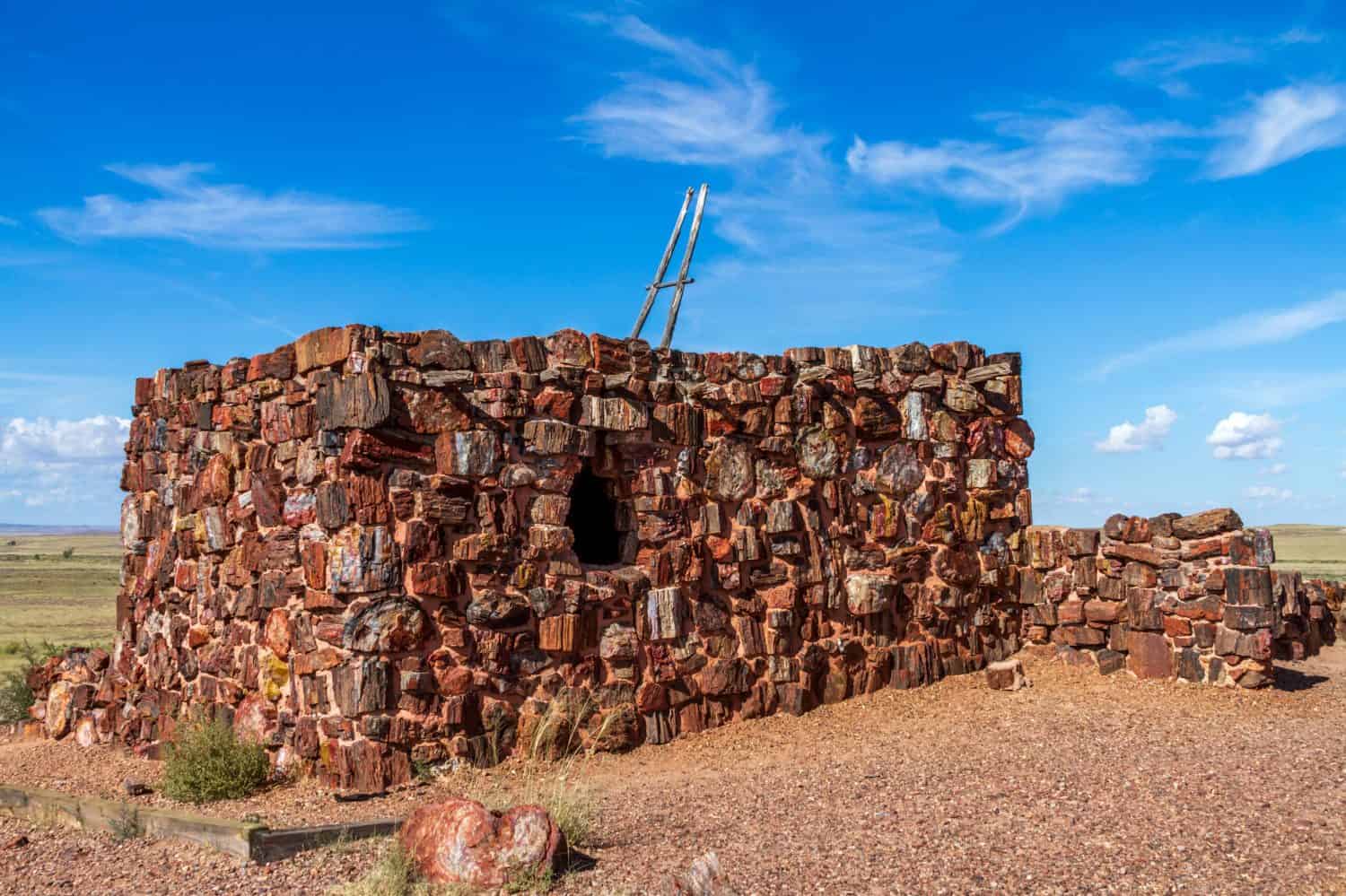
The Agate House is one of the structures still standing today inside the national park.
©Felipe Sanchez/Shutterstock.com
Early inhabitants of the area left more than a mark on this now national park. Almost 1,000 years’ worth of remnants have been found, including arrowheads, pottery shards, and other tools. There are over 500 different archeological sites within the park, each encompassing a part of history.
One of the bigger sites to see is the remains of a 100-room compound occupied more than 600 years ago by the Ancestral Puebloan people, which can be seen at Puerco Pueblo. There is also an eight-room pueblo built of petrified wood named the Agate House.
3. Teddy Roosevelt Saved the Forest
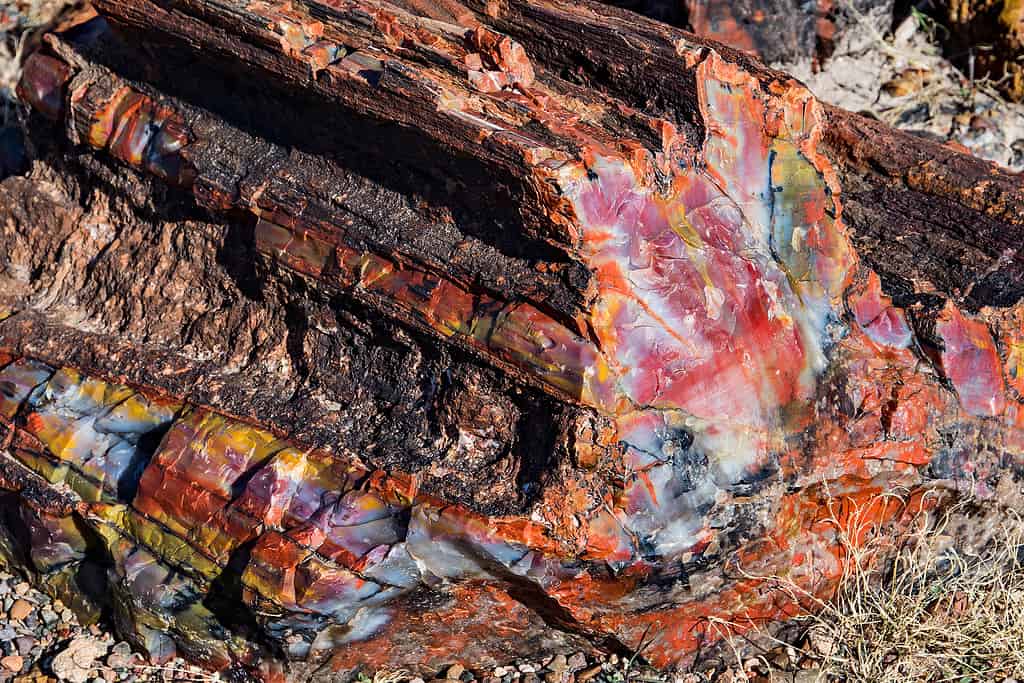
Colorful crystals form inside petrified logs after long periods of time.
©williamhc/iStock via Getty Images
In the late 1800s, petrified wood had become extremely popular. People were flocking to this northern area of Arizona to get their hands on some. This prompted the Arizona Territorial legislature to petition the U.S. Congress in 1895 to protect the resources.
So, in 1906, the Petrified Forest National Monument was created by President Theodore Roosevelt. Then, in 1962, the park was elevated to national park status. The park has since been protected from anyone tampering with it or stealing from it.
4. It Is One of the World’s Largest Petrified Forests

The Petrified Forest in Arizona is one of the biggest collections of petrified wood in the world.
©Tom Burgmeier/Shutterstock.com
There are a few noteworthy petrified forests in the world. There is one in Egypt, one in Argentina, and even one in North Dakota. However, Arizona’s park contains one of the world’s largest collections of petrified wood.
The remains here have been dated to be between 211 and 218 million years old and can be found exposed in pockets of the park in what are known as ancient “forests.”
5. There Is a Newspaper Made of Rock

Newspaper Rock has over 600 petroglyphs spread across it.
©CapturedbyKimsey/Shutterstock.com
There is an archeological site known as Newspaper Rock. No, it is not technically a newspaper, nor is it a single rock. However, it is a site that has over 650 petroglyphs spread out across a series of rocks within close proximity to one another. That makes this area of the park hugely significant.
What is a petroglyph? Well, petroglyphs are images, symbols, or designs that have been left behind by previous settlers. Park officials say that ancestral Puebloan people created the petroglyphs. They lived, farmed, and hunted along the Puerco River between 650 and 2,000 years ago.
6. The Petrified Forest Is Teeming With Life
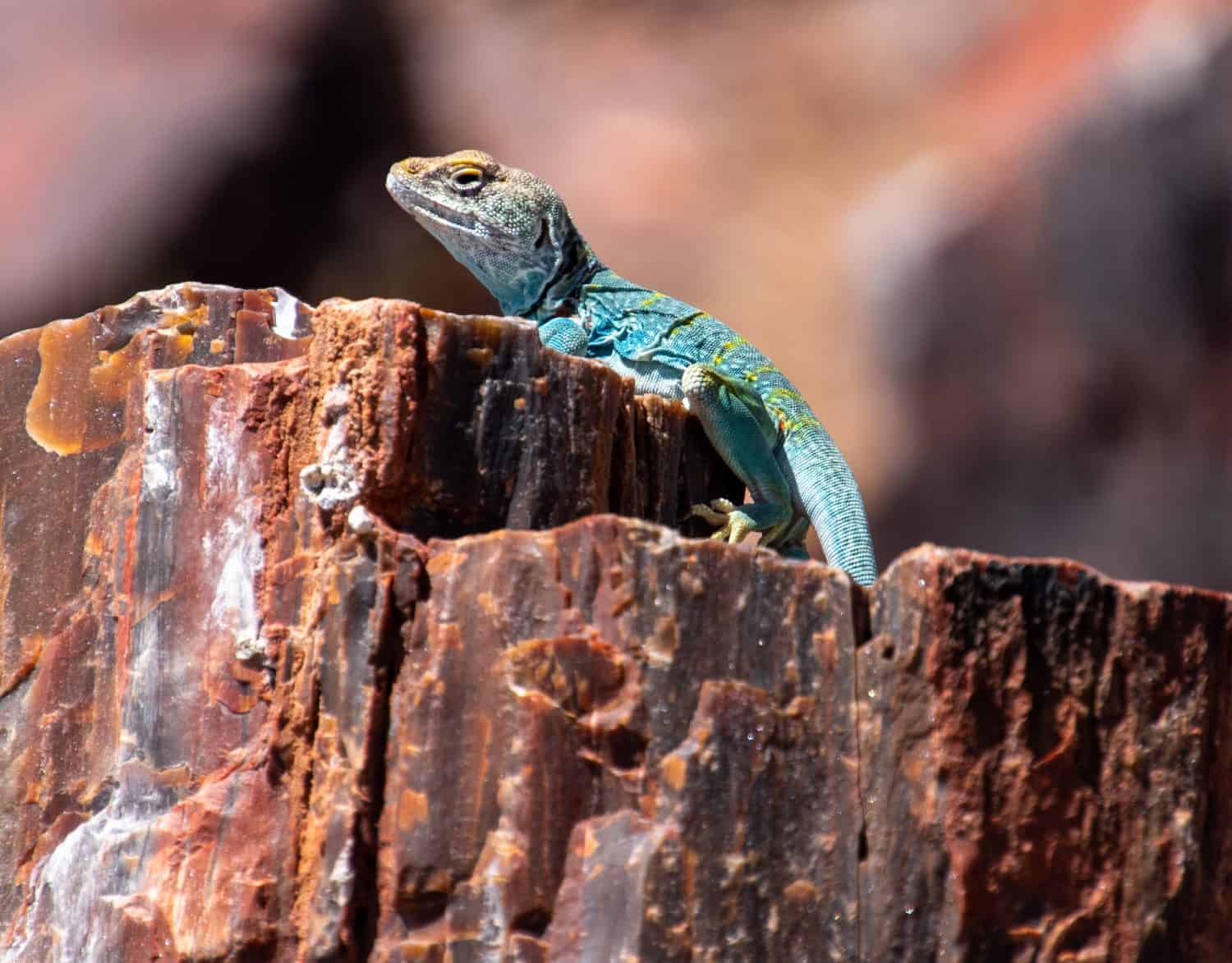
Even though the trees are petrified, the wildlife most definitely isn’t.
©RENA MICHAEL/Shutterstock.com
Some of the trees might be petrified, but there are plenty of other plants and animals that are happily thriving. Yes, dinosaurs once roamed the area, but now, there are some smaller reptiles and other creatures that call this place home.
Hundreds of species of plants and animals can be found in the park. Animals like coyotes, pronghorns, jackrabbits, and bobcats live here. There are also snakes, lizards, amphibians, spiders, and over 200 species of birds. On top of all that, you can find over 400 species of plants.
7. A Part of the History of Route 66 Is Preserved Here

The iconic Route 66 is one of the most famous roads in the world.
©Mike Flippo/Shutterstock.com
Route 66 is a story in and of itself. It is one of the most well-known roads in the world. So much so that a very popular movie was made with heavy nods to the iconic road. This stretch of road travels from Chicago to Los Angeles with stops in Flagstaff, AZ. Don’t forget Wynonna, Kingman, Barstow, and even San Bernardino.
Also known as the Main Street of America or the Mother Road, a part of this historic route is forever preserved inside Arizona’s Petrified Forest. A couple hundred years ago, train tracks traveled alongside the park. Between the 1920s and 1980s, Route 66 ran alongside the tracks. Nowadays, Interstate 40 has replaced Route 66, but a chunk of this historic road still remains.
8. The Painted Desert Is Actually Inside the National Park
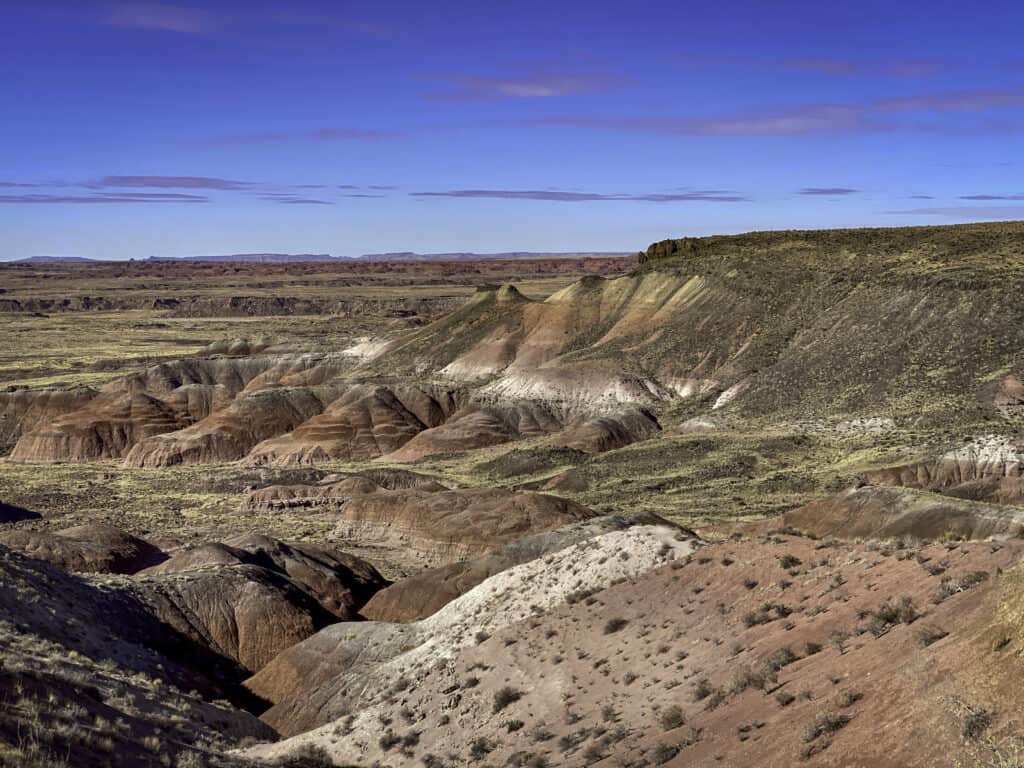
Here are some colorful hills in the Painted Desert in Arizona.
©iStock.com/Laura Ragsdale
Quite a few people believe that the Petrified Forest National Park and the Painted Desert are two separate and distinct parks. Well, they are not. The Painted Desert is actually nestled up in the northern part of the Petrified Forest. This area of badlands is in the Four Corners area, running from near the east end of Grand Canyon National Park and southeast into Petrified Forest National Park.
The Painted Desert is named for its colored layers of mudstone, shale, and siltstone. The different exposed layers look to be painted in shades of purple, white, grey, pink, red, and orange. The desert spans over 100 miles and is quite the addition to the Petrified Forest National Park.
9. Chinle Formation Is One of the Biggest Geological Formations in the Southwest
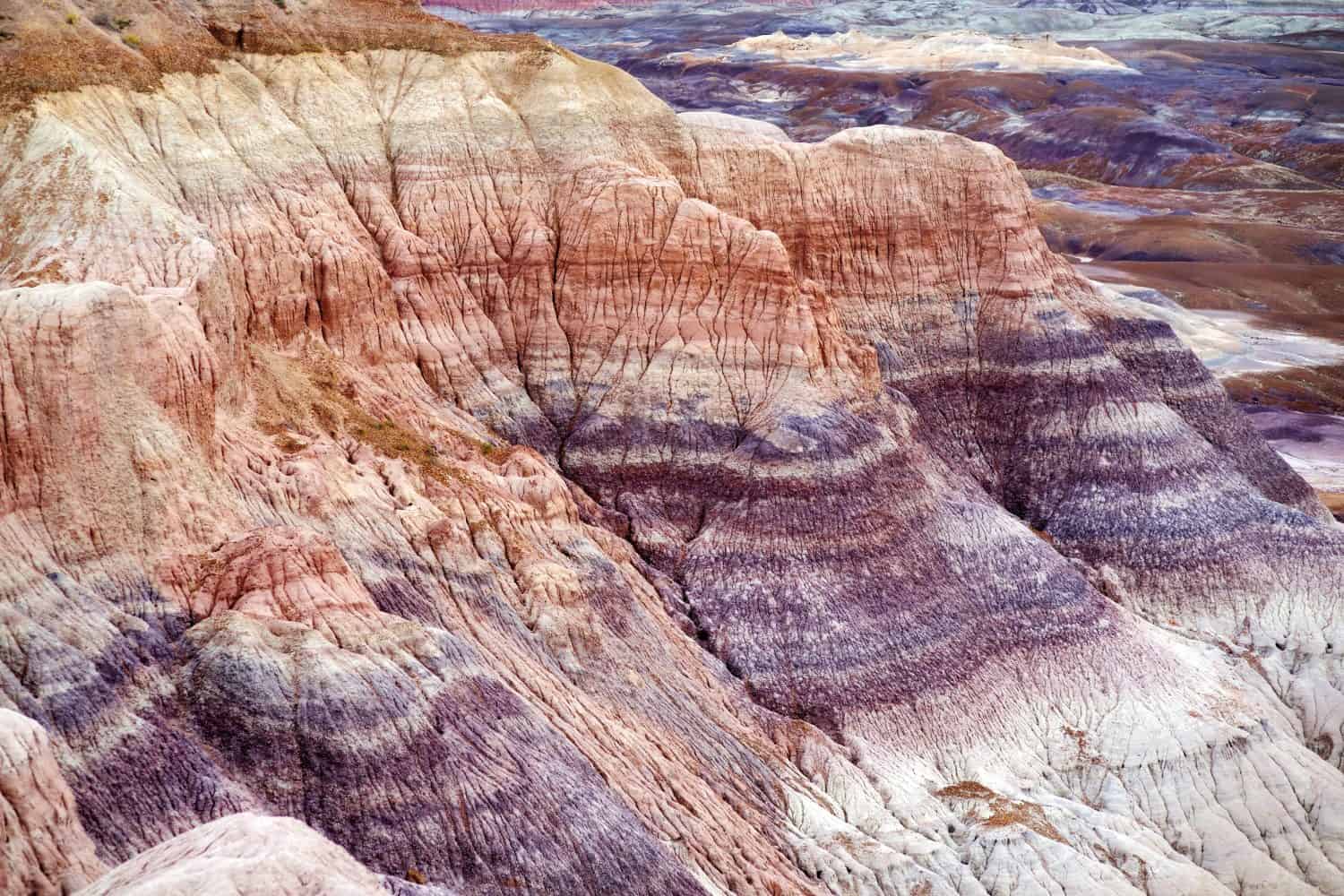
The Blue Mesa is one of the many divided formations of the Chinle Formation.
©MNStudio/Shutterstock.com
The Chinle Formation is a deposit of rock formations spread across the United States. It is in northern Arizona, Utah, western New Mexico, Nevada, and western Colorado. However, some of the most extensive deposits are inside the Petrified Forest National Park. The colorful badland hills, sculptured buttes, and flat-topped mesas of the Painted Desert are primarily made up of the Chinle Formation.
With mainly fluvial (river-related) deposits within Petrified Forest National Park, the Chinle Formation is even further divided. This also includes the Petrified Forest Member, which consists of thick sequences of reddish mudstones and brown sandstone layers. The Owl Rock Member has pinkish-orange mudstones mixed with hard, thin layers of limestone. The Blue Mesa Member, however, has thick deposits of grey, blue, purple, and green mudstones and minor sandstone beds. Finally, the Mesa Redondo Member has dark red siltstones as well as sandy conglomerates.
10. There Was a Hotel Made of Petrified Wood
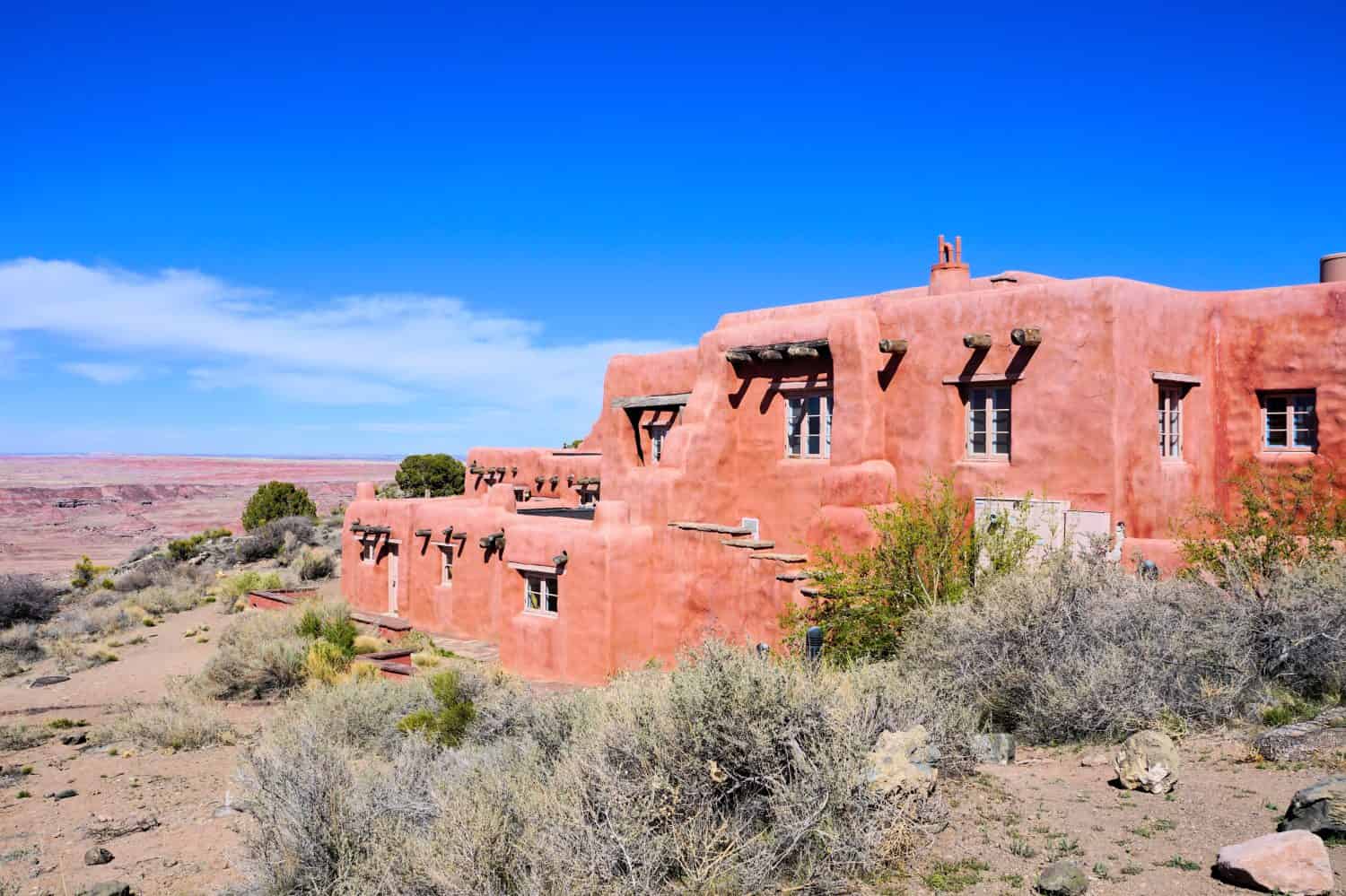
The Stone Tree House sat alongside the historic Route 66.
©JeniFoto/Shutterstock.com
The Painted Desert Inn is a historic building in the Petrified Forest National Park. The Inn was originally located near the original alignment of historic U.S. Route 66, overlooking the Painted Desert. The Painted Desert Inn was built in the 1920s out of petrified wood, a.k.a. The Stone Tree House.
Years later, the Inn no longer allows overnight guests. Nowadays, it is a museum that showcases the Civilian Conservation Corps, Route 66, and the building’s history. Even though the Inn no longer serves its patrons, every summer, there is an ice cream parlor downstairs where guests can enjoy a little bit of yesteryear.
The photo featured at the top of this post is © Juan Carlos Munoz/Shutterstock.com
Thank you for reading! Have some feedback for us? Contact the AZ Animals editorial team.







